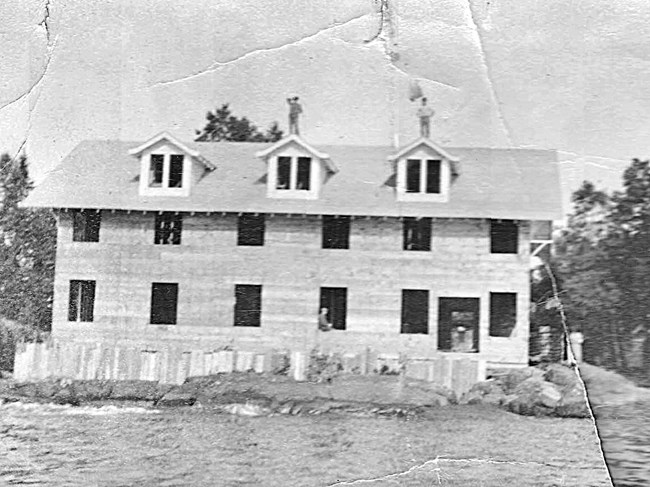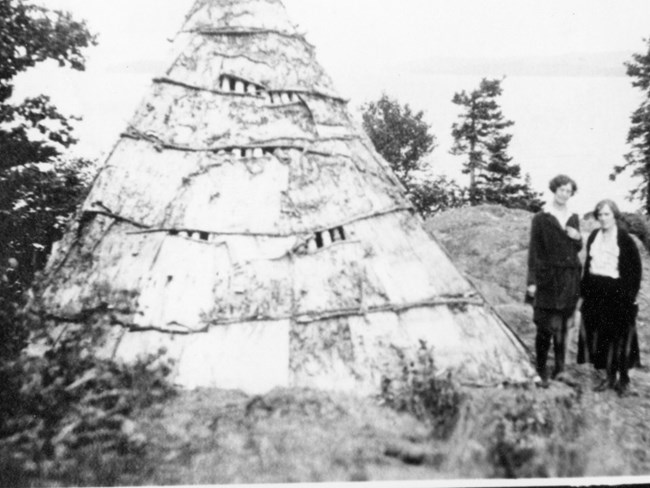Last updated: September 25, 2020
Article
Resorts History

Farmer Collection
History
By 1890, two new forces made themselves felt in the socio-economic development of Isle Royale. One was the realization, by the large companies that owned the island, that copper mining was not a paying business. This led to the search for other forms of revenue. A second came with the growing urbanization of the Midwest, the disappearance of wilderness area on the mainland, and the search for alternative areas for recreation. Out of this mixture of economic and aesthetic-recreational values came the search for summer homes and the rise of commercial resorts.
As early as 1890, the Isle Royale Land Corporation began making plans to develop the island as a summer resort. The steamer Hiram R. Dixon stopped at the island during the summer season on its way to Port Arthur from Duluth, and John F. Johns let out a cottage to such groups. Others camped around Rock Harbor, particularly around the Rock Harbor Lighthouse. The Isle Royale Land Corporation decided to make their resort area in Rock Harbor, and surveyed a townsite in section 23, T66N R33W, close to Ransom.
Development of formal resorts, however, waited until the turn of the century. In 1901, a Duluth shipping line began running excursions from Duluth to Washington Harbor at a cost of $5 per round trip. By 1902 Captain Walter H. Singer, the transportation manager, convinced the Isle Royale Land Corporation to go into the hotel business on a large scale. As one dispatch read:

H.B. Roberts Collection
The corporation, other dispatches went on to say, would convert to a summer resort, to rival Mackinac Island, at an early date. They would erect hotels, bath houses, dance halls, toboggan slides, summer theaters and cottages, and lease the concessions.
Captain Singer leased a large tract of land on Washington Island and set up a resort. The resort, consisting of a hotel and cottage accommodations, catered to Duluth clientele. Fishing, cool summer climate and absence from hay fever were the features played up in brochures and circulars. Meantime, another group of Duluthians, seeking a more exclusive type of resort, purchased 75 acres on the mainland at the head of Washington Harbor. Their purchase included a large 20-room log building, erected by the Wendigo Company as headquarters. This they set up as an exclusive club, and made the harbor head and tributary streams a private fishing ground.
The developments on the Washington Harbor area were paralleled in Rock Harbor. As early as 1901 a small establishment was located in Tobin's Harbor. In that same year, Kneut Knuetson, who had come to the island for relief of Hay fever, established Park Place at the present location of Rock Harbor Lodge. He acquired tracts of land along the lakefront, at first building cottages and renting them to summer visitors and later selling the lots. Other resorts developed on Minong Island, near the head of Tobin Harbor in Tobin Harbor itself, and on Davidson Island; and on the north of the island, Belle Isle.
Each of these resorts had its own clientele, its own distinctive characteristics and its own history but they had some characteristics in common. Life centered around a large living room with a fireplace; accommodations were both in the main building and in separate cottages. Rates charged for hotel accommodation were $23 per week for hotel, and $26.50 for cottages. Meals were excellent; Belle Isle, for example, had its own vegetable garden and chicken pen. Fresh meat came in twice a week, with the boat from Duluth; on other days lake trout were wrapped in cheesecloth, cooked in copper wash boilers, then skinned, the meat flaked off and served with cream sauce. Further attractions at Belle Isle included a tepee frame covered with bark "not authentic, but just for "fun" and an observation platform. Lodge owners performed many of the interpretive services now carried on by the National Park Service.
The rise of resorts was accompanied by the buying of summer cottages by vacationers. The Island Mine Company and the Isle Royale Land Corporation sold a large number of small tracts to those desiring a summer cottage. Island locations were particularly valued. This demand became so great that in 1914 the government had to survey a large number of small islands in Tobin Harbor, Washington Harbor, and on the north shore that had been missed in previous surveys. Buyers snapped up these islands.
In addition to the resorts, the "quai-resorts need some mention that is, the homes of working islanders, which became attractive to visitors, much as Peter Edisen's and Sam Rude's places are today. The Holgar Johnson place at Chippewa Harbor and the F.I. Francis-later the John Linklater place at Birch Isle-- are examples of this type of attraction.
